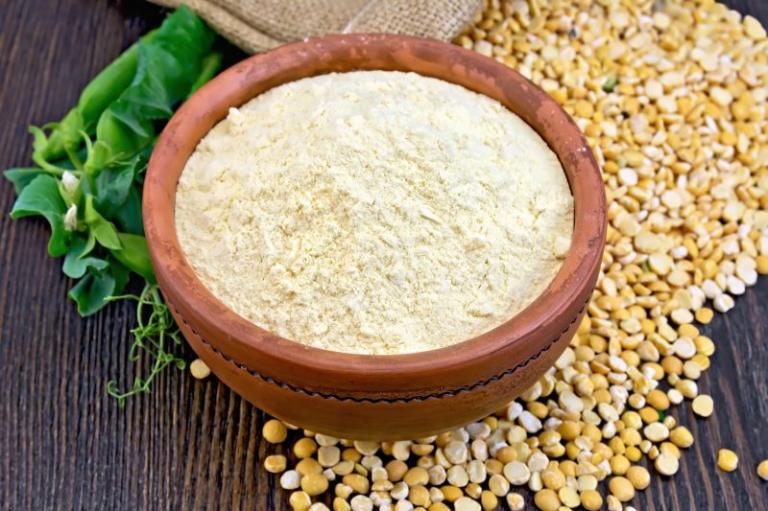Pea starch conv. and organic - Are you looking for sustainable alternatives to wheat, potato and corn starch?
Imagine using starch which is also a natural source of protein (12%), keeps all its valuable properties, and keeps your label clean, vegan, organic, and gluten-free! Beyond the functional properties that pulses provide to food, using pulse-based ingredients becomes more relevant each day mainly due to health effects, but also because of sustainability reasons.
Pulses are a crop with a low negative impact on the environment. In fact, pulses are a low carbon footprint product that not only is good for human nutrition, but also for the soil. Growing pulses benefit life in the soil, which at the same time, benefits the growth of other species of plants. Pulses need only a few amounts of Nitrogen from the soil, which means that these are capable to grow without Nitrogen fertilizers and produce less greenhouse gas emissions. Pea starch concentrate can come from both conventional and organic agriculture. Both are an alternative to make products with a low glycaemic index, particularly important to control insulin resistance-related diseases. It provides an important amount of protein, minerals, and fiber while suiting vegan, and gluten-free formulations.
In comparison with other cereal or tuber-based starches, using pea starch concentrate is a natural source of:
- Proteins
- Minerals
- Fibre
- Low digestible starch
Legumes contain twice the amount of protein than cereals. One of the main advantages of pea starch concentrate, is that the main fraction is, of course, composed by starch, but it also contains an important content of protein (around 12 %). The dry milling process means that the process to obtain starch is free from chemicals and the starch remains native.
Using a native starch provides the properties and the functionality of a “raw ingredient”. The use of native starches provides multiple advantages in different areas. It adds technological functionalities and allows to keep a clean label, as it simply needs to be declared as “pea starch concentrate”, an easy recognizable component.
- Native starch concentrates from the dry milling of peas -> ideal for clean labels without E-numbers
- Highly soluble in water -> excellent dispersion and mixing behaviour
- High resistant starch -> stability against shear forces, acids, high temperatures and enzymes
The pea starch concentrate is a product with an important content of fibre and protein. Besides its functionality, it boosts nutritional value of products from many categories such as baked products, snacks, pasta, and many gluten free items. As a result of its high nutrition content, it is especially relevant for products from the category of sports nutrition.
There is also the option to produce debittered starch. The off-flavors of a typical pea starch are neutralized without the use of chemicals keeping the functionality and a “clean label”. A debitterized product keeps its valuable properties of starch and make it suitable for many products without flavour interference.
Pea starch concentrate is ideal as a dough improver and suitable to replace soy, wheat, corn or rice in multiple applications, including:
Thickener agent (soups, creams, puddings and products that require a creamy texture)
- Pea starch is stable to shear forces, keeping a more stable viscosity than, for example, wheat starch
Gelling agent (marmalades, jells, bakery fillings)
- Pea starch requires higher temperatures to gelatinize completely, which makes it excellent option for these applications
Texture and consistency improver
- Excellent for cohesiveness in meat or vegetarian burgers
Agent for volume expansion
- Suitable for crunchy extruded products
- Expanded snacks with high nutritional value
- Possibility for low caloric snacks, high in protein and fibre
Vegan and gluten free substitute for biscuit and baked goods
- Excellent alternative to rice, wheat, soy, corn, and more
- The proteins from the starch concentrate promote a softer crumb
- Retards staling process and extended shelf life
- Economic ingredient with high impact on formulation
Nutritional profile improver for pasta and baked goods
- Complement low lysine levels contained in cereals
- In combination with gluten, viscoelastic properties are kept or improved
- Products based on pea starch have a low glycaemic index
- Source of polyphenols and flavonoids
Legume starches are an excellent option even when the intention is not to produce gluten free baked goods. Pea starch can also be used to substitute wheat flour in bakery to increase nutritional and functional value.
The outcome is to produce baked goods packed with nutrients, such as products high in dietary fibre, which at the same time promotes a lower glycaemic response. The content of dietary fibre is important in this case because it avoids high glucose peaks, as a result of low content of fast digestible starches.
The milling processes contribute to the quality of pea starch, as the well executed milling conditions affect the final product, for example, no sandy texture that scratches in the mouth, but smooth and creamy final products.
The information for this article was gratefully provided by
Viridi Foods.
support@viridi-foods.com
Let's simplify the future of change!


